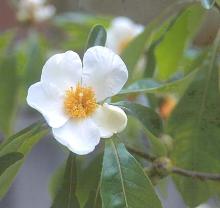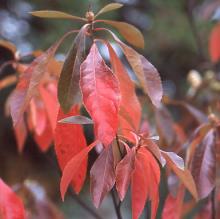Franklinia alatamaha
Common name:
Franklin Tree
Franklinia
Pronunciation:
frank-LIN-ee-a a-lah-ta-MAH-ha
Family:
Theaceae
Genus:
Type:
Broadleaf
Native to (or naturalized in) Oregon:
No
- Deciduous tree-shrub, 10-12(30) ft, [3-3.7(9) m], upright spreading, open base. Leaves alternate, simple, 13-15 cm x 0.9 cm, obovote-oblong, gradually narrowing to short petiole, terminal bud long and silky. Good fall (red) color. White flowers, 7.5 cm, with yellow centers in the fall. The fruit is slow growing, a 5-parted, more or less spherical, brown, capsule.
- Sun to part shade, somewhat difficult to transplant. Requires moist, acid, well-drained soil supplied with ample organic matter. Best fall coloration in full sun. It is often short lived in landscape situations and is known to be very susceptible to root pathogens. Blooms poorly in wet autumns in the Northwest.
- Hardy to USDA Zone 5 Once native to Georgia, no longer found in the wild. First reported by John Bartram, and his son, William, in 1765, and named after Bartram's close associate, Benjamin Franklin. It has not been seen in the wild since 1790 or 1803, and all the cultivated plants are thought to be descendants of those collected by the Bartrams.
- alatamaha: of the Altamaha River in Georgia (note difference in spelling).
- Oregon State Univ. campus: small tree on the west side of Kerr Administration.









